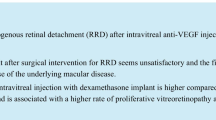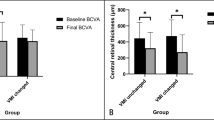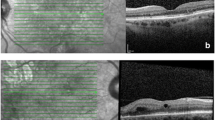Abstract
Purpose
To study the effects of repeated intravitreal injection of anti-VEGF drug bevacizumab on the vitreoretinal interface (VRI).
Methods
Patients undergoing intravitreal injection of bevacizumab were enrolled. Eyes with media haze, uveitis, high myopia, history of cataract surgery or laser capsulotomy in last 6 months and complicated pseudophakia were excluded. VRI evaluation was done monthly for a minimum of 6 months. The nature and timing of the change(s) event was recorded.
Results
A total of 100 eyes were evaluated. Thirty-seven eyes developed new vitreoretinal interface change event (VICE). Pseudophakia (OR = 5.23, 95% CI = 1.99–14.07, p = 0.001), pre-injection VRI abnormality (OR = 2.63, 95% CI = 1.13–6.14, p = 0.024) and older age at enrollment (62.6 ± 13.9 vs. 56.3 ± 14 years) were risk factors for development of VICE. Eighty percent of interface events occurred in the first 3 months of therapy. Eight needed surgical intervention for consequences of vitreoretinal separation.
Conclusion
VICE is not infrequent in eyes receiving anti-VEGF therapy though rarely need surgical intervention. The first 3 months are the critical months to watch out for these events. The treating ophthalmologists must keep the risk factors for development of in mind and monitor and counsel patients accordingly.


Similar content being viewed by others

References
Rosenfeld P, Brown D, Heier J et al (2006) Ranibizumab for neovascular age-related macular degeneration. N Engl J Med 355:1419–1431
Brown D, Michels M, Kaiser P et al (2009) Ranibizumab versus verteporfin photodynamic therapy for neovascular age-related macular degeneration: two-year results of the ANCHOR study. Ophthalmology 116:57–65
Brown D, Nguyen Q, Marcus D et al (2013) Long-term outcomes of ranibizumab therapy for diabetic macular edema: the 36-month results from two phase III trials. Ophthalmology 120:2013–2022
Schmidt-Erfurth U, Lang G, Holz F et al (2014) Three-year outcomes of individualized ranibizumab treatment in patients with diabetic macular edema. Ophthalmology 121:1045–1053
Ozturk B, Kerimoglu H, Bozkurt B, Okudan S (2011) Comparison of intravitreal bevacizumab and ranibizumab treatment for diabetic macular edema. J Ocul Pharmacol Ther 27:373–377
Rajendram R, Fraser-Bell S, Kaines A et al (2012) A 2-year prospective randomized controlled trial of intravitreal bevacizumab or laser therapy (BOLT) in the management of diabetic macular edema. Arch Ophthalmol 130:972–979
Elman M, Qin H, Aiello L et al (2012) Intravitreal ranibizumab for diabetic macular edema with prompt versus deferred laser treatment. Ophthalmology 119:2312–2318
Brown DM, Campochiaro PA, Singh RP et al (2010) CRUISE investigators. Ranibizumab for macular edema following central retinal vein occlusion: six-month primary end point results of a phase III study. Ophthalmology 117:1124–1133
Brown D, Campochiaro P, Bhisitkul R et al (2011) Sustained benefits from ranibizumab for macular edema following branch retinal vein occlusion: 12-month outcomes of a phase III study. Ophthalmology 118:1594–1602
Iturralde D, Spaide R, Meyerle C et al (2006) INtravitreal bevacizumab (Avastin) treatment of macular edema in central retinal vein occlusion. Retina 26:279–284
Rodrigues I, Stangos A, McHugh D, Jackson T (2013) Intravitreal injection of expansile perfluoropropane (C3F8) for the treatment of vitreomacular traction. Am J Ophthalmol 155:270–276
Stefansson E (2009) Physiology of vitreous surgery. Graefes Arch Clin Exp Ophthalmol 247:147–163
Gawecki M, Doroszkiewicz M, Rydzewski J (2010) Age related macular degeneration and presence of posterior vitreous detachment. Klin Ocz 112:210–212
Krebs I, Brannath W, Glittenberg C, Zeiler F, Sebag J, Binder S (2007) Posterior vitreomacular adhesion: a potential risk factor for exudative age-related macular degeneration? Am J Ophthalmol 144:741–746
Lopes de Faria J, Jalkh A, Trempe C, Mcmeel J (1999) Diabetic macular edema, risk factors and concomitants. Acta Ophthalmol Scand 77:170–175
Ondeş F, Yilmaz G, Acar MA, Unlü N, Kocaoğlan H, Arsan AK (2000) Role of the vitreous in age-related macular degeneration. Jpn J Ophthalmol 44:91–93
Schulze S, Hoerle S, Mennel S, Kroll P (2008) Vitreomacular traction and exudative age-related macular degeneration. Acta Ophthalmol 86:470–481
Nasrallah F, Jalkh A, Van Coppenolle F et al (1988) The role of the vitreous in diabetic macular edema. Ophthalmology 95:1335–1339
Yamamoto S, Yamamoto T, Ogata K, Hoshino A, Sato E, Mizunoya S (2004) Morphological and functional changes of the macula after vitrectomy and creation of posterior vitreous detachment in eyes with diabetic macular edema. Doc Ophthalmol 109:249–253
Simpson A, Petrarca R, Jackson T (2012) Vitreomacular adhesion and neovascular age-related macular degeneration. Surv Ophthalmol 57:498–509
Ophir A, Trevino A, Martinez MR (2010) Extrafoveal vitreous traction associated with branch retinal vein occlusion. Eur J Ophthalmol 20:733–739
Uchino E, Uemura A, Ohba N (2001) Initial stages of posterior vitreous detachment in healthy eyes of older persons evaluated by optical coherence tomography. Arch Ophthalmol 119:1475–1479
Duker JS, Kaiser PK, Binder S et al (2013) The international vitreomacular traction study group classification of vitreomacular adhesion, traction, and macular hole. Ophthalmology 120:2611–2619
Geck U, Pustolla N, Baraki H, Atili A, Feltgen N, Hoerauf H (2013) Posterior vitreous detachment following intravitreal drug injection. Graefes Arch Clin Exp Ophthalmol 251(7):1691–1695
Veloso CE, Kanadani TM, Pereira FB, Nehemy MB (2015) Vitreomacular interface after anti-vascular endothelial growth factor injections in neovascular age-related macular degeneration. Ophthalmology 122(8):1569–1572
Clemens C, Holz F, Meyer C (2010) Macular hole formation in the presence of a pigment epithelial detachment after three consecutive intravitreal antivascular endothelial growth factor injections. J Ocul Pharmacol Ther 26:297–299
Moisseiev E, Goldstein M, Loewenstein A, Moisseiev J (2010) Macular hole following intravitreal bevacizumab injection in choroidal neovascularization caused by age-related macular degeneration. Case Rep Ophthalmol 1:36–41
Latinize R, Ramoni A, Scotti F, Introini U (2007) Macular hole and intravitreal injection of triamcinolone acetonide for macular edema due to central retinal vein occlusion. Eur J Ophthalmol 17:451–453
Bakri S, Omar A (2012) Evolution of vitreomacular traction following the use of the dexamethasone intravitreal implant (Ozurdex) in the treatment of macular edema secondary to central retinal vein occlusion. J Ocul Pharmacol Ther 28:547–549
Mayr-Sponer U, Waldstein S, Kundi M et al (2013) Influence of the vitreomacular interface on outcomes of ranibizumab therapy in neovascular age-related macular degeneration. Ophthalmology 120:2620–2629
Waldstein S, Ritter M, Simader C, Mayr-Sponer U, Kundi M, Schmidt-Erfurth U (2014) Impact of vitreomacular adhesion on ranibizumab mono- and combination therapy for neovascular age-related macular degeneration. Am J Ophthalmol 158:328–336
Sivaprasad S, Ockrim Z, Massaoutis P, Jkeji F, Hykin P, Gregor Z (2008) Posterior hyaloid changes following intravitreal triamcinolone and macular laser for diffuse diabetic macular edema. Retina 28:1435–1442
Stalmans P, Benz MS, Gandorfer A, Kampik A, Girach A, Pakola S, Haller JA, MIVI-TRUST Study Group (2012) Enzymatic vitreolysis with ocriplasmin for vitreomacular traction and macular holes. N Engl J Med 367:606–615
Weber-Krause B, Eckardt U (1996) Incidence of posterior vitreous detachment in eyes with and without age-related macular degeneration. An ultrasonic study. Ophthalmologe 93(6):660–665
Author information
Authors and Affiliations
Corresponding author
Ethics declarations
Conflict of interest
None.
Rights and permissions
About this article
Cite this article
Kinra, V., Singh, S., Khanduja, S. et al. Evaluation of vitreoretinal interface changes in patients receiving intravitreal anti-VEGF therapy. Int Ophthalmol 38, 549–556 (2018). https://doi.org/10.1007/s10792-017-0490-x
Received:
Accepted:
Published:
Issue Date:
DOI: https://doi.org/10.1007/s10792-017-0490-x



